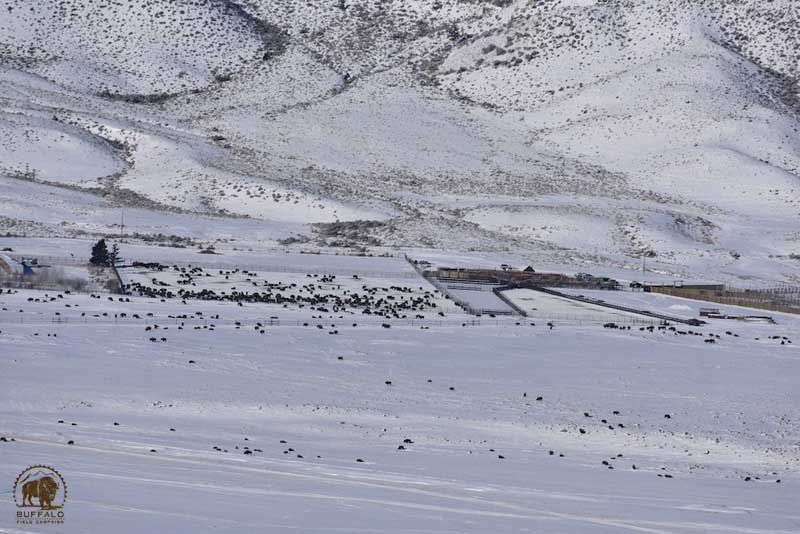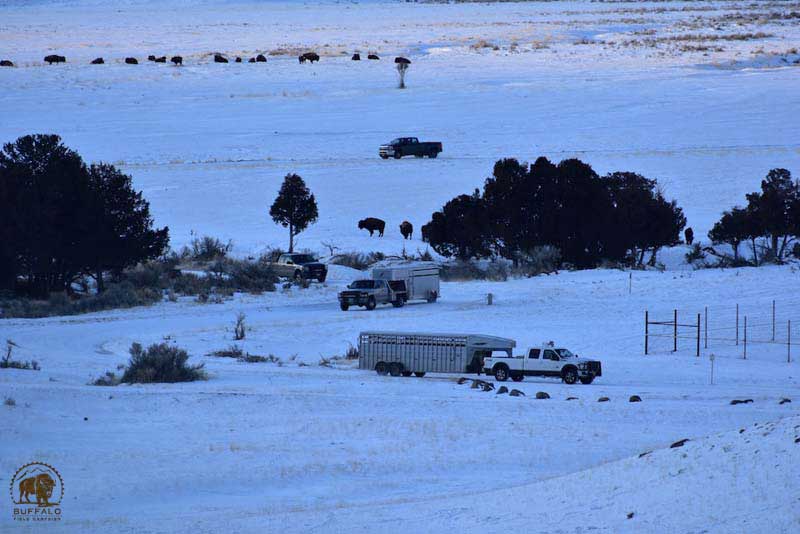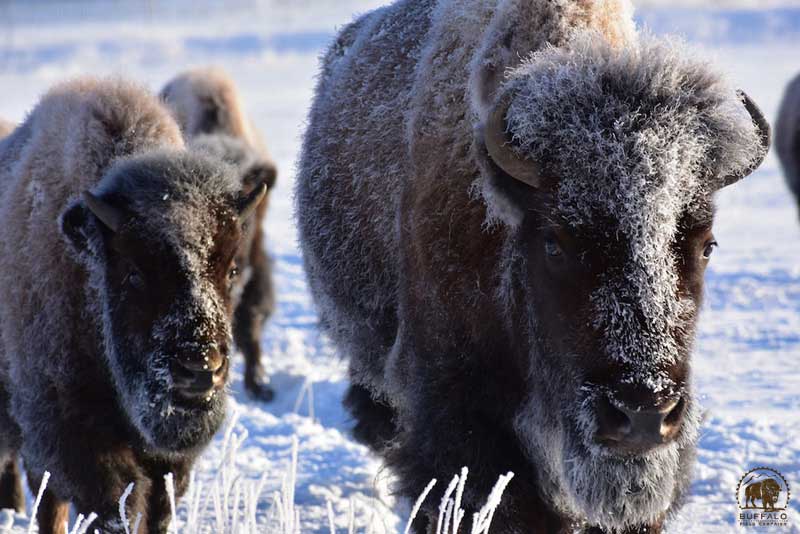Featured image: A single mom with seven calves who she is caring for. More than likely, only one of these calves are hers, and the rest of these babies are buffalo she adopted after their mothers were killed by hunters. BFC photo by Stephany Seay.
by Stephanie Seay / Buffalo Field Campaign
It’s just below zero as we trek through freshly fallen snow on an unusually windless early morning, in the high hills above the Gardiner Basin. Taking advantage of the calm air that won’t rock our scopes and cameras, our patrol is on the way to a lookout spot high above Yellowstone’s Stephens Creek buffalo trap. The trap is miles away. The spot we’re at is one of the few places that we can see even a far-away glimpse into the industrial size monstrosity that has entrapped more than 450 of the gentle giants in the past couple of weeks. Yellowstone initiates a massive seven-mile public closure around their trap, obviously wanting to hide the horrible things they are doing to this sacred species, our national mammal. On our way to the lookout, our footsteps squeaking through the freezing cold snow, one of our crew shouts out, “wolves!” We all stop dead in our tracks. To the south of us, we can hear them, the beautiful, haunting serenade of a wolf pack, singing blessing songs to the morning, or, more like mourning songs to the travesty unfolding before us. The wolves know. We get to the lookout spot and it’s as bad as we thought: hundreds of buffalo in the trap, huddled together, eating hay rations, trapped on death row. Four park wranglers on horseback, and a white SUV are coming into the northernmost paddock of the trap which holds approximately 60 of the country’s last wild buffalo. This paddock is the veritable end of the line before the buffalo go in even deeper, to places they will never return from.
“Genocide,” our Blackfeet brother says. We nod in agreement. The U.S. Government continues the systematic destruction of the sacred buffalo, and for the same reasons, too. Only, these days, instead of Buffalo Bill and Wild Bill Cody, they call it “management” and the killers are the so-called guys in green: Yellowstone National Park. Donning buffalo on their uniform badges, they are the very ones who are obligated to protect the buffalo — the buffalo who are the main reason this park even exists, that people even come here. These “caretakers” are facilitating all of the trapping and most of the killing. As we watch through our scopes and binoculars, eyes teary from the blistering cold, or the pain in our hearts, the wranglers go in for the attack. It’s just another day in the park. Frantic, the sixty buffalo run away from the wranglers, but the only path open to them is the dark corridor that leads into the labyrinth of the trap, towards the bull pen and the squeeze chute, towards the end of freedom and family, into the tiny holding pens where they will spend their last hours in feces and fear, before being loaded onto livestock trailers headed for the slaughter house. The mournful howling continues. The wolves know. We join in.

A bird’s-eye view of Yellowstone’s Stephens Creek buffalo trap. The massive closure is an attempt to keep the public from seeing what Yellowstone is doing. BFC photo by Stephany Seay.
Anticipating shipments to slaughter, the next morning we rise even earlier to get our sites on the trap before the trailers arrive. We are well ahead of schedule. Our presence, our vigilance is the only way for anyone to know what is taking place here, for anyone to know what is really happening to the buffalo. Once posted up, we send one patrol high into the hills for an even better birds-eye view. Even so, both lookouts rely on the powerful magnification of spotting scopes to see anything, and tiny-dot-anythings at that. With the naked eye, the trap and it’s happenings are hardly visible at all. The trap is so strategically located that Yellowstone’s shame and desire for secrecy are apparent. Just before dawn, multiple vehicles start arriving to the trap. The unmarked rigs of the wranglers, a few park service law enforcement officers, Yellowstone’s bison biologist, Rick Wallen, and others, get ready for another day of wild buffalo abuse. Then the stock trailers show up, flanked by law enforcement escorts. It takes less than an hour for them turn wild buffalo from sacred, free-born beings into “pounds on the hoof” headed for the slaughter house.

2018 03 01 03 003 Update3 Buffalo Field Campaign Stephany Seay 2018 800 Two stock trailers drive through Yellowstone, and groups of buffalo, taking buffalo who were captured at Yellowstone’s facility to slaughter on Wednesday morning. BFC photo by Stephany Seay.
The dominant culture — not even those who might care — can’t bear to look into the face of the reality of its actions. It views the human supreme; born out of a cold arrogance lusting for control, enabling the conversion of the living into the dead for profit. Forgetfulness, mindlessness – “with guns and laws and truth that lies” – help grease the gears of the machine; numbness is the key to conducting wildlife “management.” It is said that once you see, you cannot unsee. A self-inflicted blindness enables it —to see would break their hearts and force their souls wide open. So, with brutal efficiency, the government workers keep their blinders on, do their jobs, and hold fast to the agreed upon Interagency Bison Management Plan.
Approximately 450 wild buffalo have been captured in Yellowstone’s trap, and nearly 250 have been killed by hunters just across Yellowstone’s boundary. By Yellowstone and Montana’s own standards, the middle-end of their 600-900 kill quota — in place to appease Montana’s cattle interests — has already been met. After the last few weeks of extremely unsavory ‘hunting’ along Yellowstone’s north boundary, very few hunters have come to kill buffalo this week. Many have left here utterly disgusted, vowing never to participate in such a slaughter again.

With their enormous, shaggy heads, buffalo face into a storm. We have much to learn from our relatives, the buffalo. BFC photo by Stephany Seay.
Before and after bearing witness to this insanity, we are reminded of the real reason we are here. Other buffalo, who were not in the trap, gave us the gift of remembering and connection, the honor of being in their presence and living in the moment. They help us remember who we are fighting for — and with — and why. The buffalo help us connect with their humbling ancient wisdom; a truth so incredibly sacred because of its gentle simplicity and rightness.
The blizzard came in quick and heavy, and the buffalo moved right along with it as they always do. With their heads into the storm, grazing and walking, sparing and goofing around, they look up at us for moments with the eyes of god, the faces of ghosts, awakening memories of ages past and future potentials. Still here. Still present. Still doing what they have always done since buffalo time began. Where they walk, ravens feast on the gut piles of their recently killed relatives, strewn across the landscape at Beattie Gulch, a beautiful place that has become synonymous with death. And, yet, the buffalo still come, still offer life, staying among the living. Obstacles be damned. These ancient beings have survived Ice Ages; now the question is: can they survive the U.S. government? In the joy of sharing time and place with the buffalo, in our pain and anger fueled by management plans, being in the company of friends both human and buffalo recognizing each other, committing to each other again; in our solidarity among our comrades we understand that all of these things come from love. Profound love. The buffalo and their wildness, their teachings of sorrow and joy, their obligation to the earth, and ours to them. These realities keep awake our spirits, reaffirm and strengthen our vow: yes, you will survive, and we will give ourselves to make sure of it; fighting for you, along side you.

